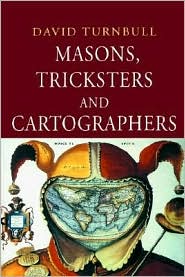 Turnbull, David. 2000. Masons, Tricksters, and Cartographers: Comparative Studies in the Sociology of Scientific and Indigenous Knowledge. New York: Routledge
Turnbull, David. 2000. Masons, Tricksters, and Cartographers: Comparative Studies in the Sociology of Scientific and Indigenous Knowledge. New York: Routledge
Turnbull aims to show that all knowledge production, including the technoscientific, is “motley”—i.e. a messy meshwork of places, practices, contingencies, and creativity. “The process of knowledge assemblage is a dialectical one in which forms of social space are coproduced. The interactive, contingent assemblage of space and knowledge, sustained and created by social labour, results in what I call a ‘knowledge space’” (4). The knowledge spaces discussed in the book include the construction practices of gothic cathedrals by masons, the production of maps by colonial and European state-makers, indigenous Pacific navigators, scientists and governments seeking a malaria vaccines, and turbulence research.
He considers all of these assemblages “forms of local knowledge,” which he says can be compared “so that their differential power effects can be explained but without privileging any of them epistemologically” (6). The question is how does this knowledge travel beyond the site of its production? And how does this assemblage of people, places, practices etc etc become linked and what kind of space does this ensemble produce?
The gothic cathedral was built without architects, plans, or common measures; it brought together a vast array of people with different “specialized” but not “expert” knowledges into a knowledge space. With the map and state being co-produced, a cartographic knowledge space is produced, while the Pacific islanders organized knowledge spatially in colonizing the worlds largest ocean. With malaria, the techno-scientific knowledge space being produced by their search for a “global” vaccine is unable to match (or admit) the utter messiness and localness of malaria itself. While turbulence research seeks to impose order to something that might be only defined as chaos.
I really liked this book and it’s important for my research. My main critiques are two: 1) I wish that Turnbull’s positioning of himself as a “trickster” would have come out in a more playful manner as I was expecting. I guess an intellectual boundary-snapping trickster is better than no trickster at all. 2) The “space” of “knowledge spaces” is a bit weird. On the one hand, I recognize that he is pointing out how knowledge is always emplaced and embodied via practice and that various assemblages are being produced—sometimes quite contingently—by all these human endeavors, but the production of space itself shines through much more in the chapters on masons, mapping, and islanders, than in the much more ambient chapters on malaria and turbulence, which are much more about knowledge than space-and-knowledge per se. (One more quibble: the book is more a series of “case studies” than genuinely comparative.)
The bridging of material, ideal, and practice has many resonances with a lot I’ve been reading, particularly from Lefebvre and other Marxists. But applied to science and technology it has a much different twist with compelling affinities:
The motley of scientific practice, its situated messiness, is given a spatial coherence through the social labour of creating equivalences and connections. Such knowledge spaces acquire their taken for granted air and seemingly unchallengeable naturalness through the suppression and denial of work involved in their construction. However, since they are motleys, they are polysemous and are capable of many possible modes of assemblage and of providing alternative interpretations and meanings. Hence all knowledge spaces are potential sites of resistance. (20)
The major difference between knowledge systems is produced by power. The power of science over, say, indigenous systems “lies not in the nature of scientific knowledge but in its greater ability to move and apply the knowledge it produces beyond the site of its production” (39). In this sense, particular configurations of people and place make particular kinds of knowledges possible. Knowledge spaces are motley affairs of practice and this is true of indigenous and technoscientific knowledge:
If we allow that all knowledge systems, from no matter what culture or period, have spatiality and localness in common, many of the small but significant differences between knowledge traditions can be explained in terms of the differing kinds of work involved in creating ‘assemblages’ from the ‘motley’ of practices, instrumentation, theories and people. Some traditions move it and assemble it through art, ceremony and ritual, whilst science does it through forming disciplinary societies, building instruments, standardising techniques and writing articles. In both cases it is a process of knowledge assembly through making connections and negotiating equivalences between the heterogeneous components while simultaneously establishing a social order of trust and authority resulting in a knowledge space. (39)

Pingback: Notes on Seeing Like a State | Territorial Masquerades